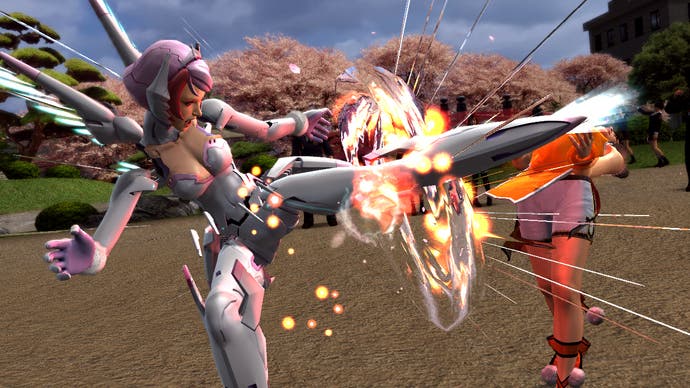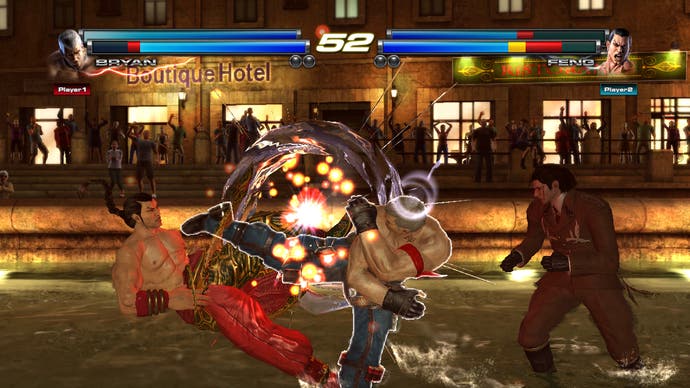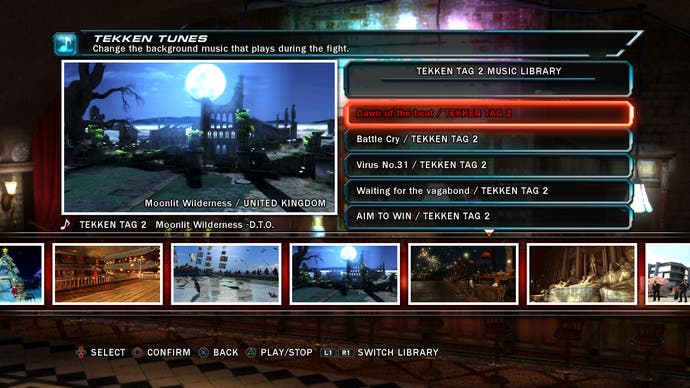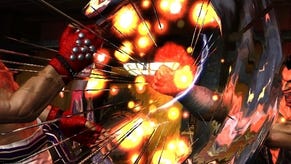Tekken Tag Tournament 2 Review
Double Jin.
When the PlayStation 2 made its emotional debut, I was too young and too jobless to afford one. None of my gaming friends made the leap either, so when I happened upon a used PS2 in a pawn shop just before Christmas 2000, I scraped all my funds together for the console and a copy of Tekken Tag Tournament. There wasn't even enough change left over to for a second controller, but when I saw that intro playing for the first time, I was instantly hooked.
You could argue that the first Tag Tournament was little more that a graphically improved version of Tekken 3 with a bolstered roster and a functional tag system - but even when played today, it's clear that Namco struck a near perfect balance between visual finesse, button-tapping accessibility and mechanical sophistication. Anyone with the faintest interest in gaming could spectate, play or spend hours in the training room with their chosen pair of characters. What's strange is that it's taken Namco well over a decade to return to one of the greatest sideshows in fighting game history.

I'm pleased to report that Tekken Tag Tournament 2 has been worth the wait, as from the opening sequence that hits the nostalgic erogenous zones in all the right places to the weighted meaning of the word "tag", Katsuhiro Harada and his team have crafted a high-quality package that should entice the dabblers back while offering added depth for the zaibatsu diehards. The only thing missing is any genuinely new characters, but with over 50 familiar faces to mix and match, the lack of new blood isn't too jarring.
You can pair Baek with Hwoarang for the ultimate taekwondo tag-team and Eddy with Christie for the shin-hacking dream - or if you'd prefer something a little less conventional, you can opt for an oddball pairing like the dainty Xiaoyu with the towering Marduk, or the kangaroo boxing skills of Roger Jr. with the stern demeanour of Dragunov. Namco has also built upon the arcade template with a number of console-exclusive characters, including the breakdancing Tiger and the metallic Prototype Jack. And even though Doctor B isn't on the guest list, you can pair Marshall and Forest together for the first time in Iron Fist history.
They're not just lazy texture swaps either, as Marshall keeps his moveset from Tekken 6 while Forest's play-style is more akin to the earlier games. As intriguing as the returning characters are, though, they'd be redundant if the tag system was limited to passing the baton rather than building combos in tandem. So thank the devil (and angel) that Tekken Tag Tournament 2 is as flexible in the combo creation department as it is on the select screen - because even if you can launch, juggle and bound with the best of them, you now have to factor in Assaults and Crashes too.

By hitting the dedicated tag button you can switch between your chosen fighters on the fly; to go the distance in a closely fought match, you need to be mindful of the Rage system that powers up your off character after your point man takes a certain number of hits. You also have to pay attention to the red health that slowly recharges when your reserve fighter isn't in use, as not only will it let them soak up more punishment, it can also be used as fuel for a range of advanced techniques.
One of these is the new Tag Assault that lets you combo with both characters the moment you land a bound attack - which is essentially a combo-extending crumple. This will sacrifice the red health of your benched character while giving your opponent a free pass to the angry dome. By letting you input a single attack string with your reserve before immediately switching back to your main, you can build some elaborate combos that make the classic 10-hitters look like a watery appetiser.
It sounds fairly abstract in writing, but the advantage of the Tag Assault system is that it encourages you to develop a working synergy with both your characters, and by layering in a number of unobtrusive training wheels - including a universal Tag Assault and the option of holding down the tag button for a scripted follow-up - Namco have made the new systems accessible without dumbing things down. And with Tag Throws that target your opponent's red health and Tag Crashes that let you sacrifice red health to switch out relatively safely, it's fair to say that Tekken Tag Tournament 2 isn't short on subsystems.
Thanks to the new Fight Lab, learning when and where to use these mechanics couldn't be easier. Far from a flyby tutorial, this mode puts you in the mechanical boots of Combot as the flamboyant Lee Chaolin tests your understanding of the fighting system. This starts out relatively straightforward with an assault course of explosive balloons that you have to carefully navigate, but by the end you're competing against a trio of badly dressed shotokan wannabes in a low gravity room where bound combos are the only way to victory. Suffice to say that learning has rarely been this fun - or surreal.

Once you've finished all five Fight Lab chapters you'll be able to customise Combot with a wide range of strikes and throws - effectively building your own mixed martial arts style from the ground up. You won't be able to use him in ranked matches, of course, but you're free to use your tailored Combot in all the offline game modes. This includes Arcade Battle, Ghost Battle, Team Battle, Time Attack and Survival, and while there's nothing along the lines of Tekken Force, Tekken Dojo or the timeless Tekken Bowling, each character has a fully animated ending movie and their fair share of customisable clothing.
Special mention also has to go to the exhaustive Practise mode, which marks the first time we've seen an input delay option that mimics five different levels of online latency. Aside from this curious addition, you get a comprehensive range of dummy settings, a recording feature that lets you test out different situations and a practice room for online players. You can even practise your combos in the training room while you wait for the matchmaking service to track down a similarly skilled opponent.
While the last game was somewhat unstable online, Tekken Tag Tournament 2 uses a modified version of the netcode used in SoulCalibur 5 to keep lag interference to a minimum. We were able to play a number of ranked and player matches against opponents as far afield as the US without suffering the dreaded treacle effect. Namco has also taken the increasingly commonplace step of bundling the game with an online pass code. But as added incentive for buying the game new, you'll be given free access to the World Tekken Federation.

Although unavailable at the time of review, the WTF is an online service available on HTML5 (so basically anything with a modern web browser) that will function similarly to Call of Duty Elite. You'll be able to build teams with other Tekken enthusiasts, take part in online competitions and track a wide range of combative stats. Whether or not this'll prove popular within the context of a fighting game remains to be seen - but if any game stands a chance of pulling it off, it's arguably Tekken (or Street Fighter, perhaps).
I've often wondered which game out of the many hundreds I've played has taken up the most of my time. It's a toss-up between GoldenEye, Monster Hunter Tri, Street Fighter 4 and Tekken Tag Tournament - and although I've never dared touch an MMO for health and sanity reasons, I'd argue that Tekken Tag Tournament 2 offers a higher return on investment than just about any other game out there.
It plays it a little safe in places and lacks a truly killer single-player mode, but by broadening the versatility of the tag system while dramatically improving the online functionality, Namco has crafted a new teamwork seminar that builds upon the original in almost all the areas that matter. Just make sure you have enough money left over for a second controller if you don't have one already. It really comes in handy.









